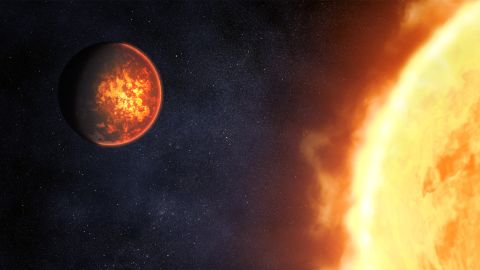!On the "planet of hell" .. the earthly year is equal to only 17.5 hours
Scientists have begun studying an intriguing planet after previous research indicated that it has a non-planar orbit with its star. Scientists have discovered that the planet revolves around its star so !quickly that the Earth year on it is equal to only 17.5 hours

The planet, officially named Janssen, orbits a star called Copernicus at an incredible speed
Astronomers are beginning to learn about the characteristics of one of the unique planets outside our solar system.
The planet "Canry 55" is known by several names, but its extremely harsh rocky nature and high temperature made it known among scientists as the "planet of hell."
This unique planet is located outside the solar system , 40 light years from Earth. Canri I55 is eight times larger than our planet, and it is so hot that it contains an ocean of molten lava with a temperature of 3,600 degrees Fahrenheit (1,982 degrees Celsius), according to CNN.
Scientists believe that the inner part of the planet may be full of diamonds due to the harsh temperatures that the components of the planet were exposed to.
Journal has been publishedNature Astronomy A study detailing the scientists' findings Thursday.

The planet, officially named Janssen, revolves around a star called Copernicus at an imaginary speed, as it completes one cycle in its orbit around its sun in less than an Earth day, which means that one year on the planet is equivalent to about 17.5 hours on Earth.
The planet's orbit is incredibly narrow, which is why Jansen's planet has such high temperatures because it is so close to the star that even before its discovery, astronomers doubted whether a planet could exist orbiting so close and so fast to any sun.
A team of researchers used a new instrument known as EXPRES, or EXtreme PREcision Spectrometer, an instrument used to determine the exact nature of planetary orbits.
The instrument was developed at Yale University by a team led by astronomer Debra Fisher and installed on the Lowell Discovery Telescope at Lowell Observatory in Flagstaff, Arizona. The spectrophotometer was able to measure small shifts in the light of Copernicus' star as the Jansen planet moved - that happens when the moon blocks the sun during a solar eclipse.

The researchers concluded that Planet Jansen rotates along the star's equator . But the “planet of hell” is not the only one that revolves around Copernicus, as there are four other planets on different orbital paths in this unique star system, according to Space.com.
Astronomers believe that Jansen's eccentric orbit indicates that the planet initially orbited farther from its star before drifting close to Copernicus, and over time the gravity of its orbiting star severely shifted its orbit.
"Astronomers expect that this planet formed very far away and then gradually reached its current orbit," said Larry Fisher, senior author of the study and professor of astronomy and Eugene Higgins, professor at Yale University, in a joint press release.
And despite the fact that Jansen wasn't always close to his star, astronomers concluded that the exoplanet was nonetheless exponentially hot.
"The planet was likely too hot for anything we know to survive on its surface," said study co-author Lily Zhao, a fellow at the Flatiron Institute's Center for Computational Astrophysics in New York.
Astronomers say that our solar system is flat like a pancake, where all the planets revolve around the sun on one level because they were all formed from the same disk of gas and dust that was revolving around the sun, unlike the fiery red planet that does not revolve in a level orbit around its star, which raises A question about how unique our solar system is in the universe.
This type of data can provide more information about how Earth-like planets and environments exist in the universe. The findings could help astronomers gain new insight into the formation of planets and how celestial bodies evolve in their orbits.
Source: websites

